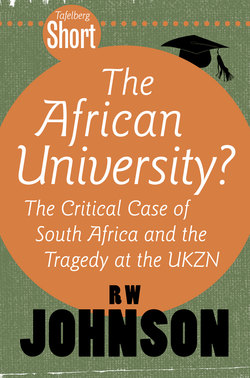Читать книгу Tafelberg Short: The African University? - RW Johnson - Страница 3
На сайте Литреса книга снята с продажи.
ОглавлениеAfrican universities in a global context
If one takes the list of the world's 400 leading universities compiled by the Times Higher Education Supplement, one can see all too plainly the enormous disparities not only between the developing world and (especially the Anglo-American) developed world but between Africa and Asia/Oceania. Five of the top 50 (Hong Kong, Melbourne, Australian National University, Singapore and Beijing) are Asian; indeed, so are twelve of the top 100, with no answering African counterpart. In fact, Africa has only four universities in the top 400 – Cape Town, Wits and Stellenbosch from South Africa, and Alexandria (Egypt). Asia has 69 – 25 Anglophone (Australia 17, New Zealand 6, India 1, Singapore 1), 23 Sinophone (China 10, Taiwan 7, Hong Kong 6), 14 Japanese, 6 Korean and 1 from Thailand. Africa is thus outgunned massively, not just 17:1 overall, but, more important, the entire continent has not a single top 100 entrant.
The same contrast exists if one compares scientific publications and patent applications. In 2002 East Asia and the Pacific region accounted for 25 391 and 65 506 of these respectively, while the comparable figures for sub-Saharan Africa were 3 696 and 101. Such data and those on university rankings are, as we know, just a shorthand indicator of intellectual life. And Africa's backwardness has great meaning. This is the world's fastest-growing continent, both economically and demographically. There are already over a billion Africans, and soon there could be two billion. If the whole world is going to be globalised into a knowledge economy, this means that Africa has to catch up. The alternative is a globalised world in which Africa alone remains as the Third World.
In some ways Africa's lag is surprising. Alexandria has, after all, been a major city longer than almost anywhere save Damascus. It was founded in 331 BC by Alexander the Great, and quickly came to have the world's largest Jewish community; Euclid worked in its great library, though of course by then it was already possible to look back thousands of years to the extraordinary achievements of ancient Egypt. North Africa was an enlightened Christian civilisation when the Britons were still painting themselves with woad, and later Arabic learning spread right across the Maghreb. Of all that, effectively little or nothing remains.
Even so, by the late colonial period there were a number of other universities of quality scattered around Africa: Natal, Rhodes and Pretoria in South Africa, Makerere (Uganda), Nairobi (Kenya), the University College of Rhodesia, Algiers (Algeria), Ibadan (Nigeria) and Dakar (Senegal), though Lovanium (in Leopoldville, today's Kinshasa, in the Congo) was often lauded as the best on the continent. An offshoot of the Catholic University of Leuven (Belgium), the university was set up in 1954 with copious aid from Belgium, the United States, Ford and Rockefeller. By 1958, under the Atoms for Peace programme, it had acquired Africa's first nuclear reactor – an acknowledgement of the fact that the uranium for the Hiroshima and Nagasaki bombs had come from the Congo.
Many other African universities had links to parental institutions in London or Paris and these served not only to maintain standards but to provide a steady interchange of talented faculty. Moreover, the era of African independence saw a number of top-class radical academics cluster first at Accra – including such names as Conor Cruise O'Brien, David Caute, Thomas Hodgkin and Alan Nunn May, the former Soviet spy. Later a somewhat similar galaxy of talent was to be found at Dar-es-Salaam, and later still in Lusaka, as first Tanzania, and then Zambia, displaced Ghana as the great black hope. However, once that hope was thoroughly extinguished by Kenneth Kaunda, the circus left town.
